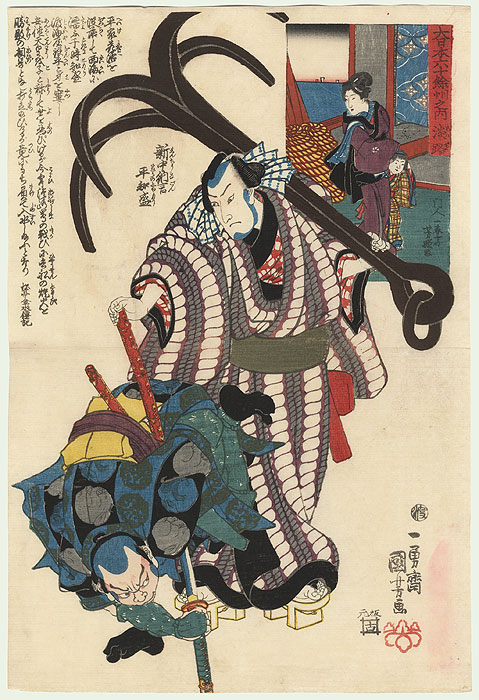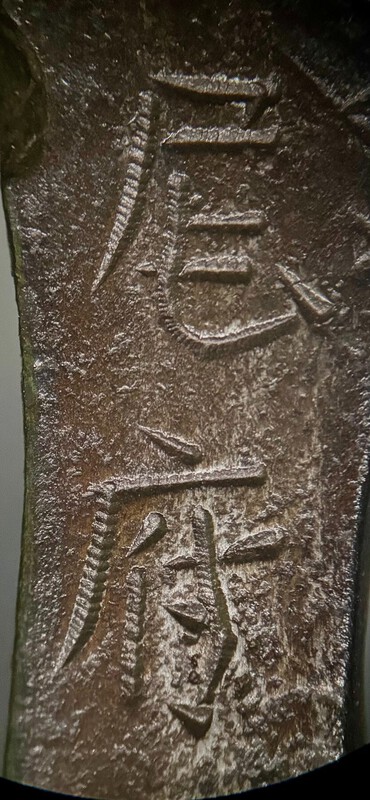-
Posts
307 -
Joined
-
Last visited
-
Days Won
2
Content Type
Profiles
Forums
Events
Store
Downloads
Gallery
Everything posted by Iaido dude
-

Itomaki-No-Tachi Koshirae (How do I match a tachi blade?)
Iaido dude replied to Iaido dude's topic in Nihonto
Sam, that's a great idea. I'm going to look into getting a tachi in shirasaya created based on the existing very well-made tsunagi. Jean, now I have an excuse to acquire a tachi stand. In the meantime... -

Itomaki-No-Tachi Koshirae (How do I match a tachi blade?)
Iaido dude replied to Iaido dude's topic in Nihonto
Any recommendations Tim and Jean for modern sword smiths who might take on the task of making a custom sword? Preferably, ones that will not break the bank? Maybe I really don't need to have a sword for this koshiare since it is largely decorative and symbolic, but it would be "way cool" as we used to say in our younger days. -

Itomaki-No-Tachi Koshirae (How do I match a tachi blade?)
Iaido dude replied to Iaido dude's topic in Nihonto
-

Itomaki-No-Tachi Koshirae (How do I match a tachi blade?)
Iaido dude replied to Iaido dude's topic in Nihonto
It does have a very nice tsunagi that fits perfectly into the saya. The chances would be quite slim I suspect to find a vintage nihonto that fits the koshirae. -
I inherited an itomaki-no-tachi koshirae like the one below from my uncle. It does not have the original tachi blade. In a general sense, how do I “size” a replacement blade that would be expected to fit the saya? This is all new territory for me since I am new to nihonto, being a tsuba collector who only has modern custom-made iaito and katana for sword practice. I’ll post a pic of my actual koshirae later, hoping that it is authentic.
-
Would you kindly post some examples of Higo guards with these features? I did notice the composition of itomaki, although I’m not sure how to put the two motifs together.
-
Thanks gentlemen. The first tsuba above actually has geese. Also, thanks Jean for pointing out that I miss-spelled kasumi (mist).
-
OK, now I'm seeing this motif everywhere. This one is an Akasaka tsuba on Jauce with a motif interpreted as mist (kaskumi), which symbolized the ethereal nature of nature and existence. Now we are getting somewhere.
-
Hahaha! That's speech recognition for you. It does kind of look like snow though...albeit a bit thorny. When approaching motifs and designs in tsuba, I always ask myself why samurai facing life and death moment to moment would want their tsuba and weapons of war decorated in such a manner. What is the power of these symbols in the stark reality of a warrior class? I can't quite fathom why this tsuba's design is meaningful to those who mounted it time and again on their blades, as we presume from examining the nakago-ana. There are sections on the symbolic meaning of clouds and snow in "Symbols of Japan," which is my go to for such information. However, neither thorns nor cocoons appear in the index. Speaking of the nakago-ana, Eckardt Kremers has hypothesized that the first generations of the Akasaka lineage were from the workship of a Shoami master associated with a signature "figure 8" appearance of the nakago-ana as a result of the way they did the fitting onto swords. The features that were appropriated for the Akasaka tsuba included those of the Kyoto, Owari, and Shoami styles. Very interesting consideration with this tsuba. Could it be a later generation unsigned Akasaka?
-
Whenever I see elements of multiple provincial schools, I suspect later Edo period tsuba that are no longer “pure“ in their features. The small size would normally make me think Kanayama, but the lack of tekkotsu argue against this. The surface treatment is simply to perfect, and without that Momoyama quality of Wabi and Sabi The large seppa-dai looks like Shoami. However, the motif itself has more of a Higo or Alaska influence. I called these guards generic Edo for want of a better description. And so as not to get too hung up on categorical names. I think that thorns and clouds are about as close to describing what is otherwise abstract.
-
Any thoughts on this smallish tsuba? 6.2 com, 0.6 cm thick. Rounded square mini. I don’t recognize the motif.
-
I especially like the last one. Classic Owari. It looks to be a big one.
-
I only have one so far, but it is really quite nice with excellent iron and a lustrous patina that is a deep chocolate brown (almost black). Exudes the quiet strength of the samurai with great niku. Early Edo Period (1600-1625) with motif of two commas (tomoe) and two nuts (konomi). 7.65 x 7.65 x 0.5 cm.
-
Wow. I'm actually writing an essay on the far eastern notion of shame. Being Chinese, I can tell you that we are born into “original shame,” not “original sin.” It is therefore not difficult to understand the darker side of bushido and kamikaze pilots during World War II. The problem with our eastern culture in this regard is that the individual is not the only one that owns the shame. It starts with ancestors, family, clan, community, province, country, and then the world. The sense of obligation and responsibility for one’s actions in relation to others is at once noble and an often unbearable burden.
-
Oh dear. What happened to the boy emperor?
-
There is an interesting historical reference to Taira No Monomori, a chief commander of the Taira clan during the Gempei War, who suffered defeat at the naval battle of Dan-no-Ura in 1185 and committed suicide with many of his clansmen by tying himself to a four prong anchor. His story was the subject of kabuki drama and woodblock prints in succeeding centuries. Later this anchor would become the symbol of the modern Japanese navy. https://www.fujiarts...on-taira-no-tomomori
-
Is the mimi round, square, or rounded square? Dimensions?
-
Thanks, Brian. I had a discussion with Steve Waszak recently about the fact that there has been little importance paid to mei on tsuba other than for attribution, and that it is possible that they stand as an art form on their own. The example we were discussing is the fact that Hoan's austere tsuba bear a rather flamboyant mei. Of course having only one signed tsuba in my small collection puts me at a disadvantage, but I am intrigued by the idea of this kind of study focusing on the art of the mei. Now I encouraged to acquire Hoan tsuba. Long before I started collecting tsuba in March, 2024, I have been a long time collector of museum quality zen painting and calligraphy. So, my primary experience was in two dimensional Japanese art in which the power instilled in the dynamic rendering of calligraphy by notable Zen masters is paramount. Here is an example from my collection. My website link at the bottom showcases all of my art collection including tsuba along with essays about Japanese aesthetics, Zen, and Zen practices including martial arts, and a photojournalistic celebration of the natural world that my family enjoys. Self Revealed Tetsugyu (1628-1700). Chinese Obaku sect Zen master who studied with Teishu, Ryukei, Ingen, Mokuen, and Sokuhi. The last three were leading Zen masters and noted calligraphers of his time. "The two characters of this bold and dynamic calligraphy in cursive script can mean 'solitary dew,' but they are part of the Zen phrase 'Self revealed among the myriad of things,' representing the state of enlightenment. According to Buddhist belief, the life of an individual is no more than a single drop of dew, but within this impermanence exists the inherent Buddha-nature, which needs only to be awakened and brought forth." [Published in: The Art of Zen: paintings and calligraphy by Japanese monks 1600-1925. Stephen Addiss; publisher Harry N. Abrams, Inc., New York (1989)].
-
What I would like to focus on in this section is an unexpected finding that I made when I examined, in detail, an apparent "texture" to the chisel technique in the execution of the mei that stood out when photographed in sunlight. Now, it may be a known technique, but it certainly surprised and delighted me. Rather than describe the finding, let's take a look at some pics, which also reveal that the surface appears to be covered with very fine tekkotsu that give the appearance of rust in direct sunlight. In sunlight, it appeared that the chisel technique for the single horizontal stroke of the kanji "kazu" was serrated. Under stereomicroscope (Fisher Stereomaster) the kanji in the mei look like they were chiseled with a very fine tool oriented in the direction of the stroke with very fine chiseling to achieve removal of iron in a sequential manner, but with a constant depth. What kind of control would this require. How remarkable. Has anyone else seen such a technique used in the carving of mei? I don't even know what this is called.
-
With the help of Curran, I have been studying the only tsuba I have that has a mei. It is made by Kazunori, who was a likely student of Shodai Norisuke and a contemporary of Nidai Norisuke based on Curran's expert speculation. The masters of this school were renown for their utsushi-mono of Nobuie, Yamakichibei, and Yagyu, as well as tsuba in their own distinct style. There is only one other that I have seen with a mei that has Kazunori (一則) engraved on the left side (Owari To Mikawa No Tanko, page 59). Mine has additional engraving on the right side to complete the name Kazunori Obu-Ju (尾府住一則), which clearly identifies him as a smith working in Owari Province. This piece is circa 1830s or 1840s when Shodai and Nidai were making tsuba with carving that wrapped over the mimi (so-called daki-moyo stye). My full write-up is attached. Owari To Mikawa No Tanko (page 59) Norisuke school Kazunori Obu Ju (Arabesque and Wickerwork.pdf
-
Really nothing to suggest Momoyama kanayama or ono tsuba. If it is Owari at all, it is very late. Anchor motif is definitely late. Maybe a homage piece.


























